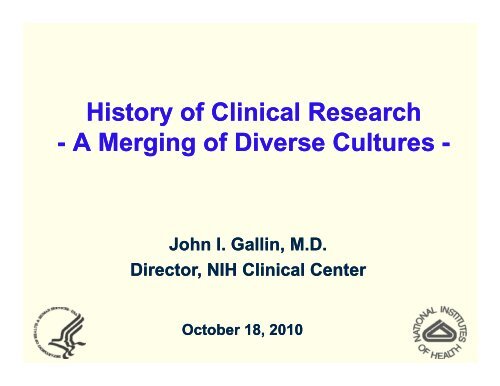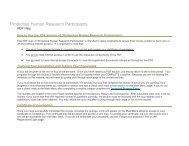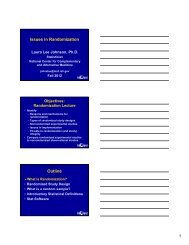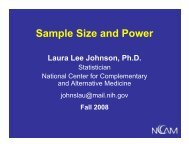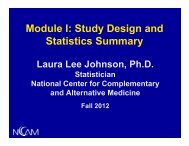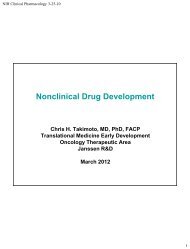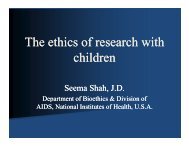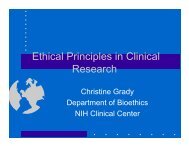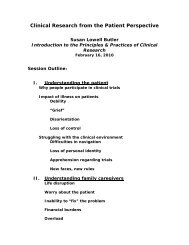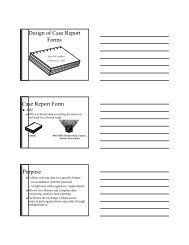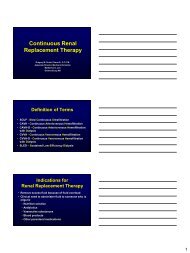History of Clinical Research - IPPCR Video and Handout Archive
History of Clinical Research - IPPCR Video and Handout Archive
History of Clinical Research - IPPCR Video and Handout Archive
You also want an ePaper? Increase the reach of your titles
YUMPU automatically turns print PDFs into web optimized ePapers that Google loves.
<strong>History</strong> <strong>of</strong> <strong>Clinical</strong> <strong>Research</strong><br />
- A Merging <strong>of</strong> Diverse Cultures -<br />
John I. Gallin, M.D.<br />
Director, NIH <strong>Clinical</strong> i l Center<br />
October 18, 2010
Outline<br />
• Course Overview<br />
• <strong>History</strong> <strong>of</strong> <strong>Clinical</strong> <strong>Research</strong>
2010-20112011 <strong>IPPCR</strong> Enrollment Data*<br />
# enrolled at the NIH: 459<br />
# enrolled at 32 remote locations: 1,035<br />
Total enrollees (as <strong>of</strong> 10/18/10): 1,494<br />
*10/18/10
<strong>IPPCR</strong><br />
32 Participating Off-Campus Sites<br />
NIH<br />
National Cancer Institute<br />
- Frederick<br />
National Institute on Drug<br />
Abuse<br />
National Institute <strong>of</strong><br />
Environmental Health<br />
Sciences<br />
New<br />
Sites<br />
U.S.<br />
Bay Pines Foundation<br />
Children's National Medical Center<br />
Harbor UCLA Medical Center<br />
Howard University Health Sciences <strong>Research</strong><br />
Medstar (Harbor Union Hospital & Washington<br />
Hospital Center)<br />
Meharry Medical College<br />
Morehouse School <strong>of</strong> Medicine<br />
Pulmonary Sleep Associates<br />
UCLA K30 Program<br />
Unity Health System<br />
University <strong>of</strong> South Florida College <strong>of</strong> Medicine<br />
Walter Reed Army Medical Center
<strong>IPPCR</strong><br />
32 Participating Off-Campus Sites (continued)<br />
International<br />
Affiliated Union Hosp, Tongji Med Coll<br />
Huazhong Univ <strong>of</strong> Science <strong>and</strong> Tech, Wuhan,<br />
China<br />
AFRICSante – Burkina Faso, West Africa<br />
Asan Medical Center <strong>Clinical</strong> <strong>Research</strong><br />
Centet – Seoul, Korea<br />
Caucaseo Scientific <strong>Research</strong> Center – Cali,<br />
Colombia<br />
Centro Internacional de Entrenamiento e<br />
Investigaciones Médicas, Cali, Colombia<br />
Dong-A University Medical College, Busan,<br />
Korea<br />
Dow University <strong>of</strong> Health Sciences (DUHS)-<br />
Karachi Pakistan<br />
Fundacion Valle del Lili – Cali, Colombia<br />
Impacta Peru - Lima, Peru<br />
International<br />
INHA University – Incheon, Korea<br />
Universidad Autonoma de Nuevo<br />
Leon, Monterrey, Mexico<br />
Universidad del Valle de Guatemala<br />
– Guatemala City, Guatemala<br />
Universidad Peruana Cayetano<br />
Heredia, Lima, Peru<br />
Universidade id d Federal de Santa<br />
Maria – UFSM, Santa Maria, Brazil<br />
U.S. Naval Medical <strong>Research</strong> Center<br />
Detachment, Lima, Peru<br />
University <strong>of</strong> Puerto Rico, San Juan<br />
Walter Sisulu University (Eastern<br />
Cape Province, South Africa)
San Juan, Puerto Rico<br />
Monterrey, Mexico<br />
Guatemala City, Guatemala<br />
Cali, Colombia<br />
Lima, Peru<br />
Bergen, Norway<br />
Beijing, China<br />
Rotterdam, The Netherl<strong>and</strong>s<br />
Chengdu, China<br />
Athens, Greece<br />
Wuhan, China<br />
Beirut, Lebanon Sui nin, China<br />
Rabat, Morocco<br />
New Delhi, India<br />
Irbid, Jordan<br />
Seoul, S. Korea<br />
Karachi, Pakistan Busan, S. Korea<br />
Riyadh, Saudi Arabia<br />
Pune, India Masan-City, S. Korea<br />
Burkina Faso<br />
Bangalore, India<br />
Incheon, S. Korea<br />
Ibadan, Nigeria Mysore, India Malaysia<br />
Singapore<br />
Santa Maria, Brazil<br />
Republic <strong>of</strong> Kenya<br />
Sao Paolo, Brazil<br />
Santiago, Chile<br />
Buenos Aires, Argentina<br />
Pretoria, South Africa<br />
Since 1995,<br />
~21,000 students world-wide<br />
wide<br />
have participated<br />
p<br />
in the NIH Curriculum<br />
in <strong>Clinical</strong> <strong>Research</strong><br />
Live<br />
<strong>Archive</strong>d
<strong>IPPCR</strong> Administrative Comments<br />
• Course Textbook:<br />
• Principles <strong>and</strong> Practice <strong>of</strong> <strong>Clinical</strong> <strong>Research</strong>,<br />
Second Edition<br />
• Available: NIH FAES Bookstore, Bldg 10,<br />
Rm B1L101 or on-line<br />
• H<strong>and</strong>outs: posted on course website:<br />
http://www.cc.nih.gov/training/training/ippcr/info.html<br />
• Lecture evaluations: link will appear on the<br />
course website following the lecture
<strong>IPPCR</strong> Administrative Comments<br />
<strong>Video</strong> <strong>Archive</strong><br />
• video <strong>of</strong> each lecture will be posted within 48hrs<br />
following presentation<br />
Questions<br />
• should be sent to the course mailbox <strong>and</strong><br />
• answers posted on course website<br />
od_ippcr@mail.cc.nih.gov<br />
cc Exam/Certificates<br />
• at completion <strong>of</strong> course, exam posted on<br />
course website<br />
• certificates t - final exam grade <strong>of</strong> 75% or higherh<br />
Questions regarding course: (301) 496-9425
Introduction to the Principles & Practice<br />
<strong>of</strong> <strong>Clinical</strong> <strong>Research</strong><br />
Module I -<br />
Module II -<br />
Module III -<br />
Module IV<br />
-<br />
Statistical Methods<br />
Ethical Issues <strong>and</strong> Regulation<br />
<strong>of</strong> Human Subjects <strong>Research</strong><br />
Monitoring Patient-Oriented<br />
<strong>Research</strong> <strong>and</strong> Regulatory Issues<br />
Preparing <strong>and</strong> Funding a<br />
<strong>Clinical</strong> <strong>Research</strong> Study
Introduction to the Principles & Practice<br />
<strong>of</strong> <strong>Clinical</strong> <strong>Research</strong><br />
Module I - Statistical ti ti Methods<br />
• Study development<br />
• <strong>Clinical</strong> trials design<br />
• Measurement<br />
• Analyzing <strong>and</strong> presenting data<br />
- Biostatistics in clinical trials<br />
- Meta analysis<br />
- Economic analysis
Introduction to the Principles & Practice<br />
<strong>of</strong> <strong>Clinical</strong> <strong>Research</strong><br />
Module II - Ethical Issues <strong>and</strong> Regulation<br />
<strong>of</strong> Human Subjects <strong>Research</strong><br />
• Ethical Principles in <strong>Clinical</strong> <strong>Research</strong><br />
• Legal Issues<br />
• <strong>Research</strong>ing an Ethics Question<br />
• Mock IRBs
Introduction to the Principles & Practice<br />
<strong>of</strong> <strong>Clinical</strong> <strong>Research</strong><br />
Module III - Monitoring i Patient-Oriented<br />
t Oi t <strong>Research</strong> <strong>and</strong> Regulatory Issues<br />
• Data management in clinical trials<br />
• Relations with the FDA<br />
• Scientific conduct<br />
• Quality <strong>of</strong> life
Introduction to the Principles & Practice<br />
<strong>of</strong> <strong>Clinical</strong> <strong>Research</strong><br />
Module IV - Preparing <strong>and</strong> Funding a <strong>Clinical</strong><br />
<strong>Research</strong> Study<br />
• Evaluation <strong>of</strong> a protocol budget<br />
• ProtoType <strong>and</strong> protocol mechanics<br />
• Inclusion <strong>of</strong> women <strong>and</strong> minorities in clinical trials<br />
• Health disparities research<br />
• Community-based participatory research<br />
• Technology transfer<br />
• Design <strong>of</strong> case report forms
Introduction to the Principles & Practice<br />
<strong>of</strong> <strong>Clinical</strong> <strong>Research</strong><br />
Special Lectures:<br />
Human Genome Project <strong>and</strong> <strong>Clinical</strong> <strong>Research</strong><br />
Christopher Austin, M.D., NHGRI<br />
<strong>Clinical</strong> <strong>Research</strong> from a Patient’s Perspective<br />
Susan Butler, B.A., M.A.<br />
Exec Dir, DC Cancer Consortium
Definition <strong>of</strong> <strong>Clinical</strong> <strong>Research</strong><br />
• Patient-Oriented <strong>Research</strong><br />
<strong>Research</strong> conducted with human subjects (or on<br />
material <strong>of</strong> human origin such as tissues, specimens<br />
<strong>and</strong> cognitive phenomena) for which an investigator<br />
(or colleague) directly interacts t with human<br />
subjects…includes:<br />
- Development <strong>of</strong> new technologies<br />
- Mechanisms <strong>of</strong> human disease<br />
- Therapeutic interventions<br />
- <strong>Clinical</strong> i l Trials<br />
• Epidemiologic <strong>and</strong> Behavioral Studies<br />
• Outcomes <strong>Research</strong> <strong>and</strong> Health Services <strong>Research</strong><br />
*From NIH Director’s Panel on <strong>Clinical</strong> <strong>Research</strong>, 1996
Imhotep in Ancient Egypt<br />
c. 2850 BC<br />
B.C.<br />
• Imhotep was a known scribe, chief lector, priest,<br />
architect, astronomer <strong>and</strong> magician (medicine<br />
<strong>and</strong> magic were used together)<br />
• Diagnosed <strong>and</strong> treated over 200 diseases,<br />
performed surgery <strong>and</strong> practiced some dentistry<br />
• Extracted medicine from plants <strong>and</strong> knew the<br />
Extracted medicine from plants <strong>and</strong> knew the<br />
position <strong>and</strong> function <strong>of</strong> the vital organs <strong>and</strong><br />
circulation <strong>of</strong> the blood system
Ancient Chinese Medicine<br />
2737 B.C.<br />
Emperor Shen Nung<br />
experimented with<br />
poisons <strong>and</strong> classified<br />
medical plants.<br />
He is reputed to have<br />
eaten 365 medicinal<br />
plants over the course<br />
<strong>of</strong> his life, turned green<br />
<strong>and</strong> died.<br />
Shen Nung (c. 2800 B.C.)
Ebers Papyrus<br />
c. 1550 B.C.<br />
• one <strong>of</strong> the two oldest preserved medical documents<br />
anywhere, (other main source: the Edwin Smith<br />
papyrus (c.1600 B.C.)<br />
• most voluminous record <strong>of</strong> ancient Egyptian<br />
medicine known<br />
• 110-page scroll, about 20 meters long, contains:<br />
• ~700 magical formulas <strong>and</strong> remedies<br />
• incantations to turn away disease-causing demons<br />
• evidence <strong>of</strong> a long tradition <strong>of</strong> empirical practice<br />
<strong>and</strong> observation.
Susruta: Father <strong>of</strong> Indian Surgery<br />
Resided at the court <strong>of</strong> the<br />
Gupta kings<br />
~600 B.C. (unclear)<br />
• Wrote medical texts about surgery<br />
• most famous: Susruta Samhita, an encyclopedia <strong>of</strong><br />
medical learning<br />
• Counted 300 bones in human body<br />
• Advocated sterilization <strong>of</strong> wounds<br />
• Discussed options for instruments; h<strong>and</strong>: best<br />
instrument
Insight from the Bedside<br />
Hippocrates<br />
• Greek physician born about 460 BC; B.C.;<br />
died about 370 B.C.<br />
• Hippocratic method<br />
- Observation paramount: “A great part <strong>of</strong><br />
the Art is to be able to observe.”<br />
- Description <strong>of</strong> pulmonary edema: “Water accumulates;<br />
the patient has fever <strong>and</strong> cough; the respiration is fast;<br />
the feet become edematous; the nails appear curved<br />
<strong>and</strong> the patient suffers as if he has pus inside, only less<br />
severe <strong>and</strong> more protracted. One can recognize that it<br />
is not pus but water…If you put your ear against the<br />
chest you can hear it seethe inside like sour wine.”
Hippocrates’ Accomplishments<br />
• Dissociated medicine from theology <strong>and</strong><br />
philosophy<br />
• Established science <strong>of</strong> medicine<br />
• Provided physicians the highest moral<br />
inspiration they have
Wound Management<br />
• “…if water was used for irrigation, it<br />
had to be very yp pure or boiled, <strong>and</strong><br />
the h<strong>and</strong>s <strong>and</strong> nails <strong>of</strong> the operator<br />
were to be cleansed. ”<br />
Hippocrates, 460 BC B.C. – 370 BC B.C.
Galen<br />
• Greek physician lived 6 centuries after Hippocrates<br />
(A.D. 129- ca. 216)<br />
• Crystallized all the best work <strong>of</strong> the Greek medical schools<br />
• Blood consists <strong>of</strong> 4 humors: black bile, yellow bile, phlegm,<br />
<strong>and</strong> blood.<br />
• Remained an unchallenged authority for >1,000 years
“…help or at least to do no harm”<br />
Hippocrates, Epidemics,<br />
Bk.1, Sect. XI.<br />
“Primum non nocere...”<br />
Galen
<strong>History</strong> <strong>of</strong> <strong>Clinical</strong> Trials<br />
“Then Daniel said to the steward…<br />
Test your servants for ten days; let us be given vegetables to<br />
eat <strong>and</strong> water to drink. Then let our appearance <strong>and</strong> the<br />
appearance <strong>of</strong> the youths who eat the king’s rich food be<br />
observed by you, <strong>and</strong> according to what you see, deal with<br />
your servants.<br />
So he harkened to them in this matter; <strong>and</strong> tested them for<br />
ten days.<br />
At the end <strong>of</strong> ten days it was seen that they were better in<br />
appearance <strong>and</strong> fatter in flesh than all the youths who ate the<br />
king’s rich food. So the steward took away their rich food<br />
<strong>and</strong> dthe wine they were to drink, di <strong>and</strong> gave them vegetables.”<br />
Daniel 1:11 – 16<br />
c. 530 BC
Iranian Medicine: Al Rhazi <strong>and</strong> Ibn Sina<br />
Al Rhazi (865-925):<br />
•Discovered use <strong>of</strong> alcohol as antiseptic<br />
•Contributions to medicine, alchemy, <strong>and</strong><br />
philosophy<br />
•1 st treatise on pediatrics<br />
•recorded in over 184 books <strong>and</strong> articles<br />
Ibn Sina - Avicenna (973-1037):<br />
• Leader in pharmacy, philosophy, medicine <strong>and</strong><br />
pharmacology<br />
• Wrote the Canon <strong>of</strong> Medicine, main European<br />
medical textbook <strong>of</strong> 14 th –16 th c.<br />
• Text contains 1 st known treatise on clinical<br />
trials – provided foundation for systematic<br />
approach to drug testing
Ibn Sina (Avicenna)<br />
“The Canon <strong>of</strong> Medicine”<br />
7 conditions for experimentation<br />
1. Drug must be pure<br />
2. Drug must be tested for only 1 condition<br />
3. Drugs must be tested in contradictory disease<br />
states<br />
4. Strength <strong>of</strong> drug must be proportionate<br />
to severity <strong>of</strong> diseases<br />
5. Time <strong>of</strong> therapeutic effect must be<br />
considered<br />
6. Drug must be observed for continued<br />
action<br />
7. Drug must be tested in humans<br />
before judgment
Leonardo daVinci<br />
(1453-1519) 1519)<br />
Born near the town <strong>of</strong> Vinci<br />
in Florence, Italy
Antonj<br />
Van Leeuwenhoek<br />
(1632-1723)<br />
1723)<br />
Born in Delft, Netherl<strong>and</strong>s<br />
• Invented microscope<br />
• Described protozoa,<br />
bacteria, striated<br />
muscle, crystalline<br />
lens, RBCs, sperm
Hematology<br />
• William Harvey y( (1578 - 1657)<br />
Defined the circulatory system<br />
• Sir Christopher Wren (1632 - 1723)<br />
First intravenous injections (in dogs)<br />
• Richard Lower <strong>and</strong> Edmund King (1667)<br />
Richard Lower <strong>and</strong> Edmund King (1667)<br />
First blood transfusion in man
Sir Christopher Wren (1632-1723) 1723)<br />
Born in Wiltshire, Engl<strong>and</strong><br />
• Anatomical drawings <strong>of</strong> the brain<br />
• First IV needle (1656) used for first<br />
blood transfusions (1667)<br />
• Instrument to measure angles<br />
• Instruments for surveying<br />
• Machines to lift water<br />
• Military devices for defending cities<br />
• Significant contributions to architecture<br />
A full human brain, drawn by Christopher Wren <strong>and</strong> included in<br />
The Anatomy <strong>of</strong> the Brain <strong>and</strong> Nerves, Feindel, W., ed., Montreal:<br />
1965.From Zimmer, C. Soul Made Flesh, NY, 2004, p.2
James Lind<br />
<strong>History</strong> <strong>of</strong> <strong>Clinical</strong> Trials<br />
• Scurvy was a major health problem for the British<br />
Navy in the 1700’s.<br />
• William Harvey had recommended lemons to treat<br />
scurvy, but had argued that the<br />
therapeutic effect was a result <strong>of</strong> the acid<br />
in the fruit.<br />
• James Lind, a naval surgeon, conducted a<br />
clinical trial in 1747 to assess the utility <strong>of</strong><br />
three therapies for scurvy.<br />
(1716 – 1794)<br />
Born in Edinburgh, Scotl<strong>and</strong>
<strong>History</strong> <strong>of</strong> <strong>Clinical</strong> Trials<br />
James Lind - Experimental Design<br />
• 12 sailors with classical scurvy, divided into six<br />
groups <strong>of</strong> two each; all given identical diets, the<br />
various groups supplemented with:<br />
- vinegar<br />
- diluted sulfuric acid<br />
-cider<br />
- sea water<br />
- nutmeg, garlic, <strong>and</strong> horseradish mixture<br />
- two oranges <strong>and</strong> one lemon, daily
<strong>History</strong> <strong>of</strong> <strong>Clinical</strong> Trials<br />
James Lind - Experimental Design (cont’d)<br />
Treatment Arm Cured P Value*<br />
Sulfuric Acid 0/2 NS<br />
Vinegar 0/2 NS<br />
Sea Water 0/2 NS<br />
Cider 0/2 NS<br />
Physician’s Remedy 0/2 NS<br />
Citrus Fruit 2/2 NS!!!!<br />
*Compared to patients in the the other 5 arms <strong>of</strong> the trial; no placebo group
Story <strong>of</strong> Smallpox
Girl with smallpox<br />
(1) Al-Rhazi– 1 st description <strong>of</strong><br />
smallpox ~900 AD A.D.<br />
(2) In the 11th century, protective<br />
measures for smallpox included:<br />
d<br />
• Putting scabs from smallpox<br />
pustules in the nostrils<br />
• Wearing the clothing <strong>of</strong> someone<br />
who had the disease<br />
Chinese artist rendition <strong>of</strong> a girl<br />
with smallpox<br />
• Ingesting powdered fleas from<br />
infected cows (may have<br />
perceived relationship <strong>of</strong> cowpox<br />
to smallpox)
Small Pox in American <strong>History</strong><br />
• 1721 – Reverend Cotton Mather (Boston) learned <strong>of</strong><br />
Variolation from African slaves <strong>and</strong> concluded variolation<br />
protected from smallpox; Mather introduced variolation to<br />
Boston<br />
• Biological warfare - used by Lord Jeffrey Amherst in 1763<br />
during Pontiac’s Rebellion, a conflict between British <strong>and</strong><br />
Native Americans following the French <strong>and</strong> Indian War<br />
• George Washington <strong>and</strong> the Continental Army<br />
• 1775 quarantine<br />
• use <strong>of</strong> immune troops<br />
• July 3, 1776: variolation approved by<br />
Continental Congress
Illustration <strong>of</strong> Edward Jenner<br />
vaccinating James Phipps<br />
Edward Jenner<br />
(1749-1823) 1823)<br />
Born in Gloucestershire, Engl<strong>and</strong><br />
Artist unknown. Undated illustration
Epidemiology
John Snow<br />
(1813-1858)<br />
1858)<br />
Born in York, Engl<strong>and</strong><br />
• British physician, i anesthesiologist<br />
i t<br />
• Medical hygiene pioneer<br />
• Father <strong>of</strong> modern epidemiology for work in<br />
tracing the source <strong>of</strong> a cholera outbreak in<br />
Soho, Engl<strong>and</strong> (1854)<br />
• Spot map illustrates cases <strong>of</strong><br />
cholera centered around pump<br />
• Statistics illustrate connection<br />
between quality <strong>of</strong> water<br />
source <strong>and</strong> cholera cases<br />
Study was major event in<br />
• Study was major event in<br />
public health history
Washing<br />
H<strong>and</strong>s
Oliver Wendell<br />
Holmes<br />
(1809 - 1894)<br />
Born in Cambridge, Massachusetts,<br />
USA<br />
Advocated h<strong>and</strong>washing<br />
in obstetrics<br />
(no data)
Ignaz P. Semmelweis<br />
(1818-1865) 1865)<br />
Born in Budapest, Hungary
<strong>History</strong> <strong>of</strong> <strong>Clinical</strong> Trials<br />
Semmelweis, 1848 - 1863<br />
• Semmelweis studied puerperal sepsis in Vienna over<br />
the protestations <strong>of</strong> his chief; he noted that the sepsis<br />
rate was three times higher in Division 1 than in<br />
Division 2; Divisions identical except medical students<br />
worked in Division 1, Midwives in Division 2.<br />
• Death <strong>of</strong> a friend following infection <strong>of</strong> an autopsyrelated<br />
wound led to his primary hypothesis that the<br />
infection was transported from the autopsy room to<br />
uninfected patients by the students.
<strong>History</strong> <strong>of</strong> <strong>Clinical</strong> Trials<br />
Semmelweis - Experimental Design<br />
• Students to wash h<strong>and</strong>s in chlorinated lime<br />
solution.<br />
• Mortality rate dropped from 18.3% to 1.3%<br />
per year; in some months in 1848 the<br />
mortality rate was 0%.<br />
• His chief did not believe his data; one year<br />
later he was fired.
<strong>History</strong> <strong>of</strong> <strong>Clinical</strong> Trials<br />
Semmelweis, 1848 - 1863 (continued)<br />
• He returned to Budapest, Hungary where he was<br />
placed in charge <strong>of</strong> an obstetrical unit plagued with<br />
an epidemic <strong>of</strong> puerperal pe sepsis. s He repeated his<br />
earlier experiment <strong>and</strong> again the mortality rate<br />
declined precipitously (mortality remained less<br />
than 1% during his six-year tenure vs. 10 to 15%<br />
in Vienna <strong>and</strong> Prague).<br />
• His major paper, “The etiology, underst<strong>and</strong>ing, <strong>and</strong><br />
prevention <strong>of</strong> puerperal sepsis” was rejected by the<br />
Vienna Medical lJournal <strong>and</strong> dhe ultimately t l had dto<br />
pay to get his work published.
Story <strong>of</strong> Antisepsis<br />
Joseph Lister<br />
(1827-1912) 1912)<br />
Born in Essex, Engl<strong>and</strong><br />
Lister’s careful trials with antiseptics were the<br />
beginning <strong>of</strong> the end <strong>of</strong> post-op op sepsis. The<br />
carbolic sprays he advocated (shown in this 1882<br />
engraving) were initially messy <strong>and</strong> unpleasant.
Physiology/Pathology
Claude Bernard<br />
(1813-1878)<br />
1878)<br />
Born in the village <strong>of</strong><br />
Saint-Julien, France<br />
• Pancreas in digestion<br />
•Glycogenic function <strong>of</strong><br />
liver<br />
•Vaso-motor system<br />
(vaso-dilator <strong>and</strong><br />
vasoconstrictor nerves)<br />
•Curare
Rudolph Virchow<br />
(1821-1902)<br />
1902)<br />
Born in Świdwin, Pol<strong>and</strong><br />
• Leukemia<br />
•Omnis cellula e cellula”<br />
every cell originates<br />
from another cell (1858)<br />
•Pulmonary emboli<br />
(thromobosis <strong>and</strong><br />
embolism)
Surgery
John Hunter (1728 – 1793)<br />
The Man who Changed the Nature <strong>of</strong> Surgery<br />
• Scottish anatomist <strong>and</strong> surgeon<br />
• Purchased services <strong>of</strong> grave robbers<br />
• To determine the nature <strong>of</strong> venereal disease,<br />
inoculated himself with infected<br />
material from a sufferer (gave him<br />
syphilis which h over the years<br />
severely damaged his heart)
Immunology
Louis Pasteur<br />
(1822-1895)<br />
1895)<br />
Born in Dole, France<br />
• Germ basis <strong>of</strong> fermentation,<br />
germ theory <strong>of</strong> infectious<br />
diseases<br />
• Discovered staphylococci as<br />
cause <strong>of</strong> boils<br />
• Described Streptococcus<br />
pyogenes as cause <strong>of</strong><br />
puerperal sepsis<br />
• Vaccine for anthrax<br />
• Vaccine for rabies
Robert Koch<br />
(1843-1910)<br />
1910)<br />
Born in Hanover, Germany<br />
•Introduced Petri dish, use <strong>of</strong> blood agar<br />
pour plates to culture bacteria<br />
•First to describe anthrax infection (1872)<br />
•Cultured M. tuberculosis <strong>and</strong> developed TB<br />
skin test<br />
•Described water-borne epidemics<br />
•Koch’s postulates<br />
•In 1905 he was awarded<br />
the Nobel Prize for<br />
Physiology or Medicine<br />
"for his investigations <strong>and</strong><br />
discoveries in relation to<br />
tuberculosis"<br />
Anthrax bacillus from a<br />
paper published by Koch<br />
in 1877
Elie<br />
Metchnik<strong>of</strong>f<br />
(1845-1916) 1916)<br />
Born in<br />
Kharkiv, Ukraine<br />
• Phagocytosis in<br />
host defense<br />
• Cellular l elements <strong>of</strong><br />
immunity<br />
• In 1908 he shared<br />
the Nobel Prize for<br />
Physiology or<br />
Medicine with Paul<br />
Ehrlich h in<br />
recognition <strong>of</strong> their<br />
work on immunity
Paul Ehrlich<br />
(1854-1915) 1915)<br />
Born in Strehlen, Pol<strong>and</strong><br />
• Described eosinophils<br />
• Described complement<br />
pathway <strong>and</strong> humoral<br />
immunity<br />
• Arsenic for treatment <strong>of</strong><br />
syphilis
Emil von Behring<br />
(1854-1917)<br />
1917)<br />
Born in<br />
Deutsch-Eylau, Germany<br />
• Discovered antibodies<br />
(diptheria antitoxin)<br />
• First use <strong>of</strong> passive<br />
immunization<br />
• In 1901 he was awarded<br />
the Nobel Prize for<br />
Physiology or Medicine<br />
"for his work on serum<br />
therapy, especially its<br />
application against<br />
diphtheria…"
End <strong>of</strong> 19 th Century:<br />
Women in<br />
<strong>Clinical</strong> <strong>Research</strong>
Florence Nightingale<br />
(1820-1910)<br />
1910)<br />
Born in Florence, Italy<br />
•Famous work in nursing<br />
•Accomplished mathematician<br />
•Math expertise dramatized<br />
needless deaths caused by<br />
unsanitary conditions in<br />
hospitals <strong>and</strong> need for reform<br />
•Major contributions during<br />
Ci Crimean War in promoting<br />
sanitary conditions for soldiers
Accomplishments:<br />
Marie Curie<br />
(1867 - 1934)<br />
Born in Warsaw, Pol<strong>and</strong><br />
- Discovery <strong>of</strong> radium<br />
- Realization that radioactivity is an intrinsic atomic property <strong>of</strong> matter<br />
- Pioneered a mobile x-ray unit for the French army in WWI<br />
- Founded d a radiological i l school for nurses<br />
- With her husb<strong>and</strong>, she was awarded half <strong>of</strong> the Nobel Prize for Physics<br />
in 1903, for their study into the spontaneous radiation discovered by<br />
Becquerel (awarded d the other half <strong>of</strong> the Prize)<br />
- In 1911 she received a second Nobel Prize in Chemistry, in recognition<br />
<strong>of</strong> her work in radioactivity.<br />
- Daughter, Irene Joliot-Curie, was awarded the Nobel Prize for<br />
chemistry in 1935 jointly with her husb<strong>and</strong> for their discovery <strong>of</strong><br />
artificial radioactivity
Blind Studies<br />
<strong>and</strong> Placebo Effect
Benjamin Franklin<br />
In 1784:<br />
• King Louis XVI <strong>of</strong> France appointed Franklin to a<br />
Royal Commission<br />
• Purpose: judge legitimacy <strong>of</strong> animal magnetism<br />
as a medical cure<br />
• Single-blind, placebo-controlled trial used by<br />
Commission<br />
• Placebo effect noted
Borrowed Ideas: Blinding<br />
• Torald Sollmann<br />
suggested a placebo<br />
control <strong>and</strong> blinded<br />
observer as a solution<br />
to investigator bias as<br />
early as 1930<br />
• Blindfold ld Tests: widely<br />
used by advertisers <strong>and</strong><br />
consumer groups in the<br />
1930s <strong>and</strong> 1940s<br />
Testing gelatins at<br />
Consumers Union, 1945
Statistics – R<strong>and</strong>omization
Borrowed Ideas: R<strong>and</strong>omization<br />
Sir Ronald Aylmer Fisher<br />
(1890-1962)<br />
1962)<br />
Rothamsted Agricultural Station<br />
• Introduced application <strong>of</strong> statistics to experimental design<br />
• Farming <strong>and</strong> plant fertility: concept <strong>of</strong> r<strong>and</strong>omization <strong>and</strong><br />
analysis <strong>of</strong> variance
Medical <strong>Research</strong> Council trial led by<br />
Sir Austin Bradford Hill<br />
1948<br />
• First clinical trial with a<br />
properly r<strong>and</strong>omized control<br />
group<br />
• Streptomycin for the treatment<br />
<strong>of</strong> tuberculosis
British Medical Journal, 10/30/1948<br />
Controlled Therapeutic Trial<br />
• “The idea <strong>of</strong> controlled investigation <strong>and</strong> statistical analysis<br />
is recent enough to call new. ”<br />
• “With a new discovery that produces dramatic results there<br />
would rarely be any doubt about the answer, but such<br />
discoveries are rare. It is the smaller, yet <strong>of</strong>ten important,<br />
advances that it is difficult to substantiate-or disprove-by<br />
such rough-<strong>and</strong>-ready read means.”<br />
• “The important point here is that without some central<br />
organization to direct the work, <strong>and</strong> without the<br />
collaboration <strong>of</strong> a number <strong>of</strong> hospitals in carrying it out, a<br />
sufficient number <strong>of</strong> patients <strong>of</strong> the same type will rarely be<br />
available.”
Medical <strong>Research</strong> Ethics
<strong>History</strong> <strong>of</strong> Informed Consent<br />
1767: Slater v. Baker & Stapleton<br />
t<br />
“…it is reasonable that a patient should be told what is about<br />
to be done to him.<br />
”<br />
1898: William Osler<br />
“To deliberately inject a poison <strong>of</strong> known high degree <strong>of</strong><br />
virulency into a human being, unless you obtain a man’s<br />
sanction…is i criminal.”<br />
i (In response to an oral presentation by Giuseppe Sanarelli<br />
on discovery <strong>of</strong> the etiologic agent <strong>of</strong> yellow fever)
Informed Consent at the NIH <strong>Clinical</strong> Center<br />
Report submitted to Medical Board by <strong>Clinical</strong><br />
i l<br />
<strong>Research</strong> Committee addressed “how to provide<br />
each patient with a reasonable underst<strong>and</strong>ing <strong>of</strong><br />
his role in a study project <strong>and</strong> the means for<br />
obtaining evidence <strong>of</strong> such underst<strong>and</strong>ing <strong>and</strong><br />
consent.”
Conclusion<br />
• The history <strong>of</strong> clinical research can<br />
be traced to all cultures.<br />
• The future requires information<br />
exchange to maximize progress in<br />
health care.
<strong>History</strong> <strong>of</strong> <strong>Clinical</strong> <strong>Research</strong><br />
- A Merging <strong>of</strong> Diverse Cultures -


